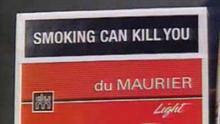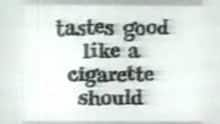Stop us if you’ve heard this one before: A popular product promises relaxation and reward, with a hint of sex appeal. Experts say it causes cancer and should carry a warning label. Many people say the warnings won’t work. The industry is less than thrilled.
Ring any bells?
Since the day in 1963 when Minister of National Health and Welfare Judy LaMarsh declared in the House of Commons that smoking causes lung cancer, Canada has been among the world leaders in anti-smoking initiatives, including warning labels.
Sixty years later, experts are warning that alcohol is a cancer risk and its packaging should get similar treatment.
While the two stories are similar, people who have spent years studying or promoting anti-tobacco advocacy say alcohol labelling does not need to play out the same way — arduously and incrementally.
“I think we’ve learned a lot from from the endlessly long, drawn-out steps,” said Geoffrey Fong, a professor at the University of Waterloo and an investigator with both the Ontario Institute for Cancer Research and the International Tobacco Control Policy Evaluation Project.
“I think we can go right to doing what’s right.”
A trend-setter
Starting with LaMarsh’s warning — which came the year before a renowned U.S. Surgeon General’s report that confirmed smoking triggered lung cancer in men — Canada has been at the vanguard of smoking regulations.

It was the first country to ban smoking on all domestic airline flights in 1987 and international flights of its domestic airlines in 1994. Calgary was the first city to host a smoke-free Olympics in 1988. And Canada was the first country to implement health warnings with pictures on cigarette packages, in 2001.
But none of it was easy.
Garfield Mahood, who proudly recounts his decades with the now-defunct Non-Smokers’ Rights Association, says getting specific, graphic warnings on cigarette packaging was a long struggle against hesitant politicians and litigious tobacco companies.
“By God, they did not want the packages to have these warnings in Canada,” he said.
Canada has had several phases of tobacco warning labels.
Before the late 1980s, there were voluntary warnings, including a request to “avoid inhaling.”
Then came the first mandatory warnings:
- Smoking reduces life expectancy.
- Smoking is the major cause of lung cancer.
- Smoking is a major cause of heart disease.
- Smoking during pregnancy can harm the baby.
Mahood said the early warnings were “camouflaged” on the package so that nobody would notice — so much so that he said any resistance from the public was minimal. They simply didn’t register the warnings, he said.
Due in large part to his organization’s work, Mahood said, starker warnings in the early 1990s such as “Smoking can kill you” were moved to the top of the packages in graphic black and white instead of the brand’s chosen colours.
WATCH | New warning labels on cigarettes in 1993:
Every package of smokes will soon feature hard-to-ignore warnings about the risks of smoking. Aired on CBC’s Prime Time News on March 19, 1993..
“Ottawa is trying to make it impossible for a smoker to say they didn’t know how much damage smoking can cause,” CBC’s Peter Mansbridge reported in 1993.
Graphic photo warnings first appeared in 2001, with several iterations since then, including the standardized plain packaging used now.

Tobacco companies not on board
Tobacco companies did not agree with the new rules implemented in the 1980s and called the bigger warnings in 1993 “harassment.” They said the labelling doesn’t work.
“The claim has always been made that this is the measure that is going to do the trick, this is the measure that is going to lead to an accelerated rate of decline,” Rob Parker of the Canadian Tobacco Manufacturer’s Council told CBC News in 1993. “And that has not happened.”
In 1995, the Supreme Court of Canada decided many of the current tobacco rules were unconstitutional, including the warnings, which it ruled were a violation because they were unattributed, and therefore appeared to come from the companies themselves. Some companies added attribution afterward.
WATCH | From the archives, a court victory for Big Tobacco:
The Supreme Court rules that government restrictions against cigarette advertising are unconstitutional.
In 1997, Parliament passed the Tobacco Act, reimposing advertising restrictions and letting the government regulate cigarette packaging. The companies fought that too, but this time lost at the Supreme Court unanimously in 2007.
As for the average consumer, whether in 1988, 1993 or 1995, Canadians who spoke to CBC News about changes to packaging were almost universally dismissive.
“I enjoy it and I’ll quit whenever I’m ready,” one woman said.
“I don’t even read what’s on the pack of cigarettes,” said a man.
“They’re all gonna taste the same inside,” said another.
WATCH | In 1988, smokers were unimpressed with warning labels:
CBC reports on the Tobacco Products Control Act from Windsor, Ont., in 1988
Regardless of whether the warnings ever worked for those individuals, “there is no doubt that the concentrated campaign against smoking has had significant impact,” a CBC News report said in 1995 — and that trend has continued.
In the 1960s, half of Canadian adults smoked. By 1995 it was less than a third. Today it’s about one in ten.
Fong, the Universtity of Waterloo professor, says studies show the labels work — in particular, the graphic ones in use today.
“The graphic warning labels that we have evaluated in Canada and many other countries all demonstrate a powerful impact on increasing the effectiveness of these warning labels,” he said. Canada, the U.K., Malaysia and Kenya are among the places that have seen an impact, he said.
Mahood estimates Canada’s policies have saved millions of lives in this country and in other countries that followed Canada’s lead.
Lessons for alcohol labelling
So what can the experts calling for cancer warnings on alcohol learn from the anti-smoking lobby?
Specificity and severity are important aspects of the warnings, Fong said. So, for instance, alcohol companies already warn that if you’re pregnant you shouldn’t drink.
“Well, that’s just the start because we know a lot more about specific diseases, whether or not you’re pregnant.”
Specific cancers or the increased risk of heart disease or stroke should be mentioned on individual labels, he said, as well as guidance on how much a person who wants to reduce their drinking should drink.
Awareness doesn’t go from zero to 100 per cent, Fong said, but it might go from 25 per cent to 38 per cent, for instance.
WATCH | Most people unaware of the risks of drinking:
There’s overwhelming evidence that alcohol causes cancer, and yet most people are unaware of the risks that come with drinking even a small amount. CBC’s Ioanna Roumeliotis breaks down the latest information and the growing push for mandatory warning labels.
Mahood has thoughts on the labels — avoid large blocks of text, and don’t say something “can cause cancer” when you can say it “causes cancer.” But his biggest message for labelling advocates is the amount of work it will take to get anything done.
“I think this will be every bit as difficult as the tobacco fight unless there is strong advocacy, and it’s going to have to be hard-hitting advocacy, not the warm and fuzzy messages that come out of health agencies.”
He said if they don’t play “strong, sometimes charismatic hardball,” nothing like the tobacco warnings will take place.
“The alcohol industry will simply overwhelm them in the offices of the politicians,” Mahood said.









More Stories
Global measles cases nearly doubled in one year, researchers say
How to make conversations with aging parents a little less awkward | CBC Radio
N.S. mom calls for better ultrasound access after private clinic reveals twins | Globalnews.ca